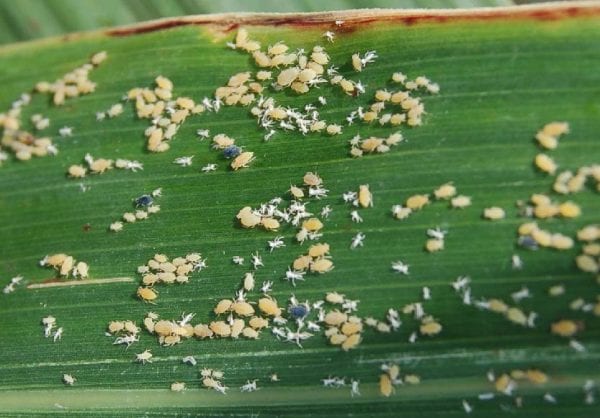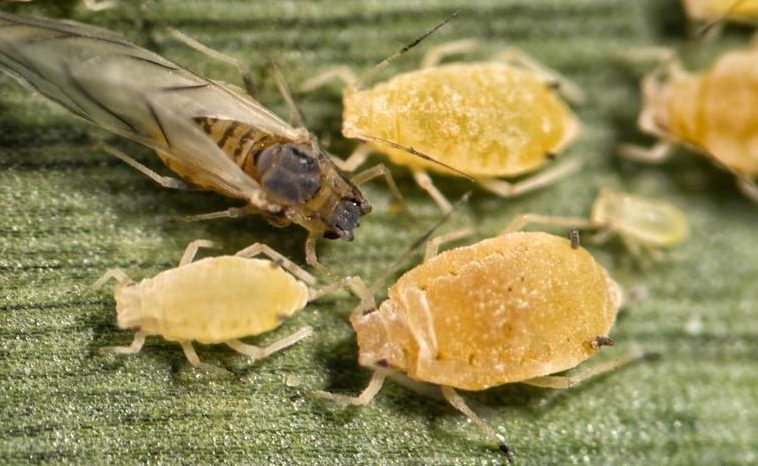Crop Production

The sugarcane aphid is a serious economic problem on grain sorghum in Mexico and the Caribbean, the southern states along the U.S. Gulf Coast, and in more northern locations after the aphids migrate from the south.
Distribution
The sugarcane aphid, first detected in 2013 on grain sorghum along the Gulf Coast of Texas and Louisiana, spread to grain and forage sorghums in more than 400 counties in 17 states by the end of 2015—more than 90 percent of US grain sorghum acreage. The rapid geographic expansion across sorghum production regions was assisted by wind dispersing winged aphids from infested southern regions to more northern locations. In North America, their presence was previously restricted to sugarcane, and the cause of this recent invasion onto sorghum is unknown.
Seasonal Occurrence

Figure 1. Aphid nymphs, wingless adults, black aphid mummies (aphids killed by a parasitic wasp), and white caste aphid skins from molts on a leaf.
Populations overwinter on remnant and ratoon (stubble and sprouts) sorghum in more southern regions with mild winters. Johnsongrass, a common alternative host, is more cold-tolerant than sorghum and also serves as a winter refuge plant. Winged aphids carried on the wind can spread locally to nearby fields and also over long distances to more northern regions, coinciding with grain sorghum coming into production. After a colony establishes, wingless daughters of winged aphids mature and reproduce at a prolific rate— populations exceeding 10,000 aphids on a single plant have been observed. The aphid gives birth to live young. Aphid colonies can expand from small, non-damaging patches to damaging populations covering much of the underside of leaves. As sorghum matures, aphids are also found on stems and in the heads. Warm, dry weather is particularly conducive to population increase on sorghum.
Damage
Sorghum damage results from a combination of loss of plant nutrients, increased plant water stress, induced leaf chlorosis, and reduced photosynthesis because of the buildup of sooty mold on the honeydew the aphids excrete. Initially, sorghum foliage remains green despite the presence of numerous aphids (Fig. 1). An uncontrolled infestation can reduce the number of heads and seed weight, increase head sterility, delay plant development and maturity, and lead to plant death (Fig. 2). Additional loss of grain sorghum at harvest is possible because heads fouled with sticky honeydew can affect grain quality and harvest efficiency. In forage sorghum, mold can reduce sorghum quality and honeydew buildup can cause cutting and baling problems.
Aphid Identification

Figure 2. Left: Grain sorghum damage caused by heavy sugarcane aphid pressure above 500 aphids per leaf (insert shows underside of infested leaf). Right: Crop infested with less than 50 aphids per leaf. Source: J. Gordy and M. Brewer, Texas A&M AgriLife
Sugarcane aphids range from gray to tan or light yellow. They are typically gray during cool periods and light yellow in warm summer conditions. The aphid has short, dark cornicles (tailpipe-like structures), dark tarsi (feet), and slender antennae that darken near the tip. Winged sugarcane aphids look similar to wingless, but have black markings that run crossways on their backs, conspicuous dark veins in their wings, and black, hardened structures at the base of their wings. With 10-power magnification, it is easy to distinguish both winged and wingless forms from other aphids that infest sorghum
Management
In southern areas, begin weekly aphid monitoring for first detection soon after plants emerge. In more northern areas, use information from southern latitudes about crop maturity and aphid population growth to help time monitoring. Once a field is infested, evaluate aphid risk twice a week to determine if and when to treat with insecticides. Contact local pest management professionals for information on insecticide choice and application timing.
Some sorghum hybrids show reduced damage from sugarcane aphids. Resistant hybrids will likely become a major sugarcane aphid management tool. Insecticide-treated seed is effective in protecting young plants, but not if aphids arrive after the seed treatment wears off.
Natural enemies of sugarcane aphids include lady beetles, syrphid flies, green and brown lacewings, and aphelinid parasitoids. Field observations indicate that even in the presence of natural enemies, aphid populations can increase to damaging levels. Selecting insecticides specific to aphids or sucking bugs can help conserve these natural enemies.
As more sorghum hybrids with at least partial aphid resistance become available and natural enemies fully ad to this new aphid as prey, the combined impact of sorghum resistance and natural enemies should improve aphid management.
Download a PDF of Sugarcane Aphid; A New Sorghum Pest of North America, ANR-2356.

